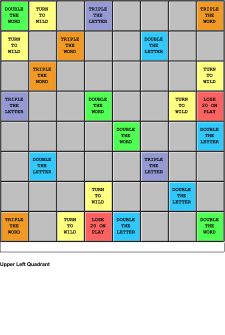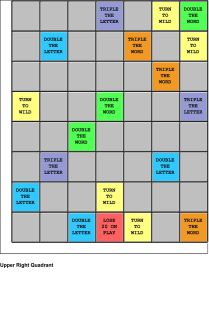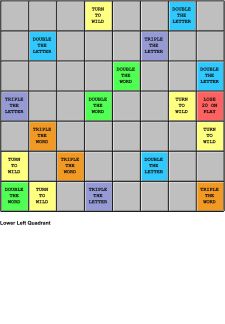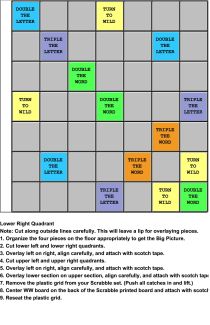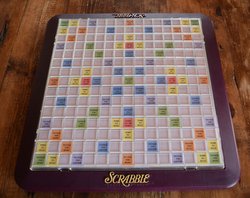WildWords Free Kit Instructions
Questions or feedback welcomed: roizen@ix.netcom.com
If something is confusing, let me know, then check back on this page the next day.
Printing the Board Click on the image of each panel below to download and display a PDF file of the panel. These files should be automatically loaded by Adobe's Acrobat Reader which is freely available online. You probably already have it. The files are about one and a half megabytes each. When you print these files with Acrobat, you can set a scaling factor as a percentage. It's usually in an Advanced Settings dialog box. If you set the factor to 100%, you will end up with a board which is 12.5 inches wide and 13.5 inches tall (excluding any white side margins). This happens to be perfect for the Scrabble Deluxe set I have mentioned. You can make the board and also the area for one tile bigger or smaller by raising or lowering the scaling percentage. You could start by printing just one panel at 100% to see if an adjustment is necessary. Put one tile on a square. If you want more space for a tile, try increasing the scaling factor. If you want less space, decrease it (say, try 95 instead of 100). When you have found the right factor that works for you, print the other three panels using the same value. Follow the instructions on the last panel to assemble the complete image of the board. Scissors and Scotch tape required. The paper board should work fine on a flat table. At a later point, you may want to add some backing, print it on stiffer, glossy paper yourself, or take a copy of these four sheets to a copy shop and see what they have to offer as a classier surface.
When assembled, you should have the image below. I left a bit of a white border in this case. 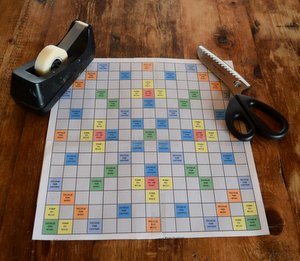 If you have the exact Scrabble Deluxe board I have with the exact playable area dimensions (above) and the removable grid, you can pop the plastic grid off (plastic catches on bottom) and scotch tape the new board to the back of the Scrabble board insert. Play either game by switching which side is up and using the right tiles and corresponding rules. Warning: There also appears to be a board currently for sale that looks like this, but the grid cannot be removed.
Printing The Rules Click this link to download the rules and print them. This is also a PDF file which should be opened by the Adobe Acrobat Reader automatically. You can print on 8.5 by 11 inch paper. The rules were actually printed on a smaller booklet format (5.5 x 8.5 inch), thus your pages will have some extra white space to the right and at the bottom. Modifying Tiles The actual point value on letters is not crucial to experiencing the game, since WildWords is mostly about using all seven tiles in a play. It takes the same skills to find that great play with a 10 point Z (Scrabble) as it does with a 7 point Z (WildWords). Of course, it is easier to use the Z in WildWords. The distribution of letters in WildWords is more important than letter points though both were based on the frequency letters occur in all words of all lengths. The exact distribution of tiles with point values is in the rule book if you need a reference or want to check your work. To get the correct distribution of letter tiles from a 100 tile Scrabble Set, remove the following 18 tiles: 2 Blanks, 2 A's, 1 D, 2 E's, 1 G, 3 I's, 1 L, 1 N, 2 O's, 1 T, 1 U, and 1 V. Put six of the removed tiles away. Take the other 12 and designate them as asterisk/wild tiles. You don't need to display an asterisk. You just need to recognize the tile as a wild tile. Cover up the existing face of the tile. Tiles in WildWords can end up flipped on the board so you want one side to be totally blank.  To try the game without damaging any tiles, just
use cut squares of masking tape a bit smaller than a tile and place those pieces over each of the 12 tiles. To try the game without damaging any tiles, just
use cut squares of masking tape a bit smaller than a tile and place those pieces over each of the 12 tiles. Combine the modified tiles with the other 82 tiles you didn't put away, and you have 94 tiles with the correct distribution of letters and wild tiles. You can stop here and start playing the game! While the point values don't affect an individual play, they do somewhat change a certain balance in the game across plays. Whereas Scrabble has 5 tiles that are 5 points or more, WildWords has 11. Making a 7-tile play with a "W" in it is harder than just using a "W" in a short word. And making a 7-tile play with a higher point letter on a triple letter and with the whole word covering a triple word and a double word actually happens. In such cases, the well placed 5 point letter contributes 90 points to the word's score. Experienced players don't just look for any 7-tile play, they look for a great one. And these plays are thrilling to make. [With the experience of having done the tile below, I would say a razor knife and straight edge would be better than scissors. And, a pair of tweezers to place the label would be better than fingertips.] To correct the points on letter tiles, you will need to change: B's to 4, C's to 2, F's to 5, G's to 3, H's to 3, K to 6, L's to 2, Q to 9, U's to 2, V to 6, W's to 6, X to 7, Y to 5, and Z to 7.  That's a total of 25 tiles. I think the easiest way to do this is to
use some blank peel and stick sheet or similar blank labels. A copy
shop could be a place to find what you need without buying a box of it.
Perhaps you have some return address labels with a blank area on them?
That's a total of 25 tiles. I think the easiest way to do this is to
use some blank peel and stick sheet or similar blank labels. A copy
shop could be a place to find what you need without buying a box of it.
Perhaps you have some return address labels with a blank area on them? 1. For each tile, peel back an area and cut a suitable right angle triangle that will cover the corner of the tile where the point value is. My experience suggests peel then cut is easier than cut then peel, and larger triangles are easier to cut and place than small squares. 2. Put the triangle over the corner of the tile. 3. Write the correct point value on it neatly. It isn't as bad as you think, and you can save the effort for a rainy day or delegate it to someone who has an allowance to earn. Hope you E*OY WildWords! Peter |
